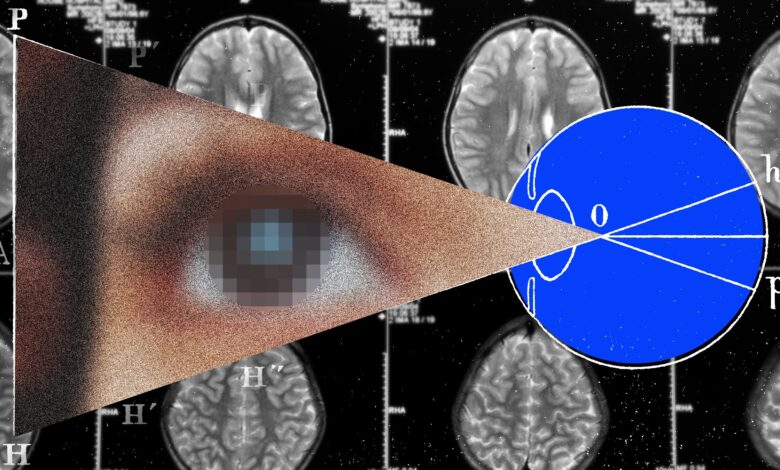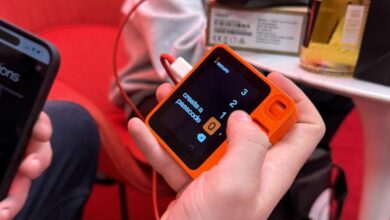The Next Frontier for Brain Implants Is Artificial Vision

Brian Bussard has 25 tiny chips in his brain. They were installed in February 2022 as part of a study testing a wireless device designed to produce rudimentary vision in blind people. Bussard is the first participant.
Bussard, who’s 56, lost vision in his left eye at age 17 after his retina detached. The right eye followed in 2016, leaving him completely blind. He remembers the exact moment it happened. “It was the hardest thing I’ve ever gone through,” he says. Eventually, he learned to adapt.
In 2021, he heard about a trial of a visual prosthesis at Illinois Institute of Technology in Chicago. Researchers cautioned that the device was experimental and he shouldn’t expect to regain the level of vision he had before. Still, he was intrigued enough to sign up. Thanks to the chips in his brain, Bussard now has very limited artificial vision—what he describes as “blips on a radar screen.” With the implant, he can perceive people and objects represented in white and iridescent dots.
Bussard is one of a small number of blind individuals around the world who have risked brain surgery to get a visual prosthesis. In Spain, researchers at Miguel Hernández University have implanted four people with a similar system. The trials are the culmination of decades of research.
There’s interest from industry, too. California-based Cortigent is developing the Orion, which has been implanted in six volunteers. Elon Musk’s Neuralink is also working on a brain implant for vision. In an X post in March, Musk said Neuralink’s device, called Blindsight, is “already working in monkeys.” He added: “Resolution will be low at first, like early Nintendo graphics, but ultimately may exceed normal human vision.”
That last prediction is unlikely, considering vision is such a complex process. There are huge technical barriers to improving the quality of what people are able to see with a brain implant. Yet even generating rudimentary sight could provide blind individuals with greater independence in their everyday lives.
“This is not about getting biological vision back,” says Philip Troyk, a professor of biomedical engineering at Illinois Tech, who’s leading the study Bussard is in. “This is about exploring what artificial vision could be.”
When light hits the eye, it first passes through the cornea and the lens, the outer and middle layers of the eye. When light reaches the back of the eye—the retina—cells there called photoreceptors convert it into electrical signals. These electrical signals travel through the optic nerve to the brain, which interprets those signals as the images we see.
Without an intact retina or optic nerve, the eyes can’t communicate with the brain. This is the case for many people with total blindness. The types of devices that Troyk and Neuralink are building bypass the eye and optic nerve completely, sending information straight to the brain. Because of this, they have the potential to address any cause of blindness, whether due to eye disease or trauma.
The specific brain region that processes information received from the eyes is called the visual cortex. Its location at the back of the head makes it easily accessible for an implant. To place the 25 chips in Bussard’s brain, surgeons performed a routine craniotomy to remove a piece of his skull.
The chips in Bussard’s brain are actually miniaturized stimulators that emit a mild electrical current. One chip is about the size of a pencil eraser and contains 16 tiny electrodes, each thinner than a human hair. Each electrode can be controlled individually. Altogether, Bussard has 400 implanted electrodes. “It’s like a cell phone network in your brain,” Troyk says.
A camera mounted to a pair of glasses captures Bussard’s surroundings. Those images are processed with special software and translated into commands that talk to the network of chips, turning on individual electrodes to stimulate neurons. The stimulation produces visual perceptions called phosphenes that look like dots of light—except no light is actually reaching the eye.
Because the stimulators are clustered in one part of the visual cortex, Bussard only sees phosphenes in the lower left part of his visual field. But it’s enough to improve his ability to navigate in a room and perform basic tasks, such as picking out a plate among four different objects on a table.
Producing better images is one of the major challenges of these systems. “The more electrodes you have, the more phosphenes you could produce in theory and the more complex shapes you could generate artificially,” says Xing Chen, assistant professor of ophthalmology at the University of Pittsburgh.
Last year, Chen and her colleagues published a study on a visual prosthesis they created with 1,024 electrodes. When they tested the system in monkeys, it allowed the animals to recognize artificially generated letters. To restore low vision in people, estimates of the number of electrodes needed range in the hundreds to thousands. But Troyk thinks it’s not so much the number of electrodes but their location that’s important; spreading them out across the visual cortex could produce more spots of light across a larger visual field. The tradeoff though, is that that could mean a more invasive surgery.
In the study at Miguel Hernández University in Spain, volunteers received just one implanted device containing 100 electrodes. Yet even that system allowed a 60-year-old woman to identify lines, shapes, and simple letters, according to results published in 2021. Researchers have since replicated the findings in three additional blind volunteers, according to Eduardo Fernández, the neuroscientist leading the study.
He stresses that artificial vision is “not like seeing again.” His main goal is to improve orientation and mobility in blind people. In one test, a man wearing the prosthesis is able to avoid objects while walking on a treadmill in front of a virtual reality video screen. In the future, Fernández wants to add more electrodes to increase the number of phosphenes to produce more detailed images.
For now, his team is learning a lot from the study’s four initial volunteers. Everyone’s visual cortex is a little bit different, so researchers have to experiment with the placement of the implanted electrodes and how much electrical stimulation to deliver. “We customize the stimulation for each volunteer,” Fernández says.
Tailoring the implants for optimal performance is a challenge. In early experiments at producing artificial vision, researchers used large electrodes placed on the brain’s surface that needed relatively high electrical currents to produce phosphenes. The stimulation sometimes caused seizures, pain, and damage to the brain tissue. Chen says there’s a balance between needing a strong enough current that induces phosphenes but doesn’t cause unwanted side effects.
Another hurdle is the longevity of devices that are implanted in the brain. In the studies from Pittsburgh and Spain, researchers used a rigid device called a Utah array, a square grid of 100 tiny silicon needles, each with an electrode at the tip. The Utah array can last months to years but can stop working when scar tissue forms around the implant and interferes with its ability to pick up signals from nearby neurons. The Illinois team’s implants look like the heads of miniature hairbrushes and are made of iridium oxide, a type of metal.
Neuralink and others are developing devices with smaller, more flexible electrodes that penetrate the brain. For instance, Neuralink’s coin-shaped device sits in the skull with thin, threadlike electrodes extending into the brain tissue. Chen says softer electrodes have the potential to improve an implant’s longevity, but it remains to be seen how long these alternatives will last in the brain.
Another unanswered question is whether the duration of a person’s blindness will affect how well these devices work. The first participant in the Spanish study had been blind for 16 years and yet was able to see crude shapes. And Bussard had been completely blind for six years.
“We do know that after years of blindness, the visual system starts to degenerate,” Chen says. “It’s possible that the sooner you are able to intervene, the better, although this remains to be systematically studied and proven.”
In a November 2022 event, Musk claimed that “even if someone has never had vision ever, like they were born blind, we believe we can still restore vision.” Fernández isn’t so sure, but notes that restoring vision in someone born blind has never been tried before. He says in theory, a person would need to have a functioning visual cortex. But people who are born blind have never used that part of the brain to process visual information.
Right now, Bussard is limited to using his visual prosthesis in the lab, where researchers can control the stimulation. Troyk and his colleagues are working on a mobile system so that future study participants could use the device at home. Troyk is looking for additional volunteers who lost their vision as an adult but who had normal or near-normal vision for at least the first 10 years of life. In the Spanish study, participants are implanted with the visual prosthesis for six months before having it removed as part of the trial protocol.
Bussard says he would love to use the device outside the lab. He has a dog who’s deaf and partially blind, and he jokes that it would be a lot easier to find his dog if he could use his prosthesis at home. But he knows he may not benefit much from the device in his lifetime. “I’m not necessarily doing this for me,” he says of his participation in the trial. “I’m doing this for future generations.”



